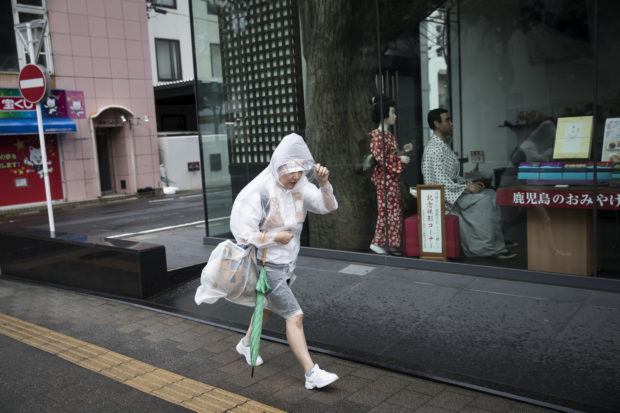
A pedestrian wearing a rain cover walks on a street after Typhoon Trami hits the city of Kagoshima, on Kyushu island, on September 30, 2018. AP
KAGOSHIOMA, Japan — A powerful typhoon hurtled toward Japan’s mainland Sunday after injuring dozens on southern islands, as weather officials warned that fierce winds and torrential rain could trigger landslides and floods.
Typhoon Trami has already sparked travel disruption in the world’s third-biggest economy, with bullet train services in the west of Japan suspended, more than 1,000 flights cancelled due to the closure of a key airport hub and Tokyo’s evening train service scrapped.
The storm is forecast to smash into the mainland near Osaka at around 6pm local time (0900 GMT) and churn across the Japanese archipelago, likely hitting areas still recovering from a series of extreme weather events that have battered Japan in recent months.
Trami tore through the southern island of Okinawa on Saturday, bringing winds strong enough to flip over cars. Several houses were flooded or damaged and 40 people on the island sustained minor injuries but no one was feared dead, local officials said.
Nationwide, authorities issued non-compulsory evacuation advisories to some 349,000 residents, while 300,000 households have lost power, according to public broadcaster NHK.
As the typhoon barreled east, rail authorities took the highly unusual step of cancelling evening train services in Tokyo, one of the world’s busiest networks, urging passengers to shelter indoors when the storm hits.
The typhoon is not expected to hit the capital head on but strong winds and heavy rain are still feared from later Sunday and some businesses were already putting up shutters and hunkering down.
Trami is the latest in a string of extreme natural events in Japan, which has suffered typhoons, flooding, earthquakes and heatwaves in recent months, claiming scores of lives and causing extensive damage.
Packing maximum gusts of 216 kilometrers (134 miles) per hour, Trami was expected to travel over most of the archipelago, weakening slightly but causing extreme weather into Monday, forecasters said.
Still classed as a “very strong” typhoon, Trami pounded Kagoshima on the western tip of Japan early Sunday, causing 10 minor injuries — for example, cuts from broken windows and people knocked over by gusts.
“We are strongly urging our residents to stay indoors because it is extremely dangerous to be outside now,” Masaaki Tamaki, an official of Kagoshima’s disaster management section, told AFP.
‘Bang, bang’
The Japanese meteorological agency warned the typhoon would bring strong winds and downpours, which could trigger landslides and floods as well as lightning strikes and tornados across the nation.
Violent gusts swept away roof tiles on some houses in Kochi city in western Japan.
“There was a big ‘bang, bang’. That woke me up,” a local elderly man in Kochi told national broadcaster NHK.
Cities in the expected path of the typhoon were already taking measures to mitigate possible danger.
East Japan Railway announced that it would gradually suspend train services in and around Tokyo and end all trains around 8pm (1100 GMT), shortly before the typhoon was to draw near the Japanese capital.
“Shinkansen” bullet train services, particularly those in western areas, also reduced or cancelled their services.
Osaka’s Kansai Airport, which is situated on reclaimed land offshore and suffered extensive damage in a storm earlier in September, closed two runways and officials piled up sandbags to avoid a repeat of flooding seen during the previous storm.
Some western regions are still recovering from the most powerful typhoon to strike the country in a quarter of a century in early September. Typhoon Jebi claimed 11 lives and shut down Kansai Airport, the main regional airport.
Deadly record rains also hit western Japan earlier this year and the country sweltered through one of the hottest summers on record.
Also in September, a magnitude-6.6 earthquake rocked the northern island of Hokkaido, sparking landslides and leaving more than 40 people dead. /ee